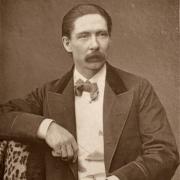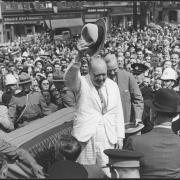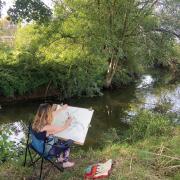A book collector and antiquary who gathered together the largest collection of tomes in the 19th century which ran to some 40,000 books and 60,000 manuscripts, making my modest library look, well, modest, Thomas Phillipps was something of the eccentric in my opinion. Phillipps’ ceaseless endeavour permitted him to accumulate the largest private collection of this kind of stuff in Britain and possibly in the whole of western Europe.
Thomas Phillipps was born in Manchester on 2nd July 1792, the illegitimate son of textile manufacturer Thomas Phillipps Snr. and Hannah Walton. Despite his birthplace the Phillipps family was long established in Broadway by all accounts. By the time he’d attained the age of 16 he’d already acquired over 100 books, which was both commendable and atypical. He attended Rugby School and then University College, Oxford, from where he graduated in 1815. Five years later, in 1820, he was elected FRS (Fellow of the Royal Society). His collecting, begun whilst still at school, was already out of hand as he walked into bookshops to buy up the whole stock and expended up to £5,000 a year on volumes, buying everything a catalogue offered, sweeping up a job lot at an auction; there was simply no end to it. His country seat, Middle Hill, near Broadway, had only four rooms not devoted to books.

In 1819, Phillipps married Henrietta Molyneux, a general’s daughter, who’d be his spouse until the year of the Great Reform Act, 1832. There were three children of this marriage, all daughters. The marriage took place after the death of his father, in 1818, who’d opposed the marriage on the grounds that Henrietta didn’t come weighed down with a substantial dowry (those were the days). Thomas Phillipps Jnr. did inherit a significant fortune though, including his father’s Middle Hill estate in Broadway, so did have something to thank his old man for. That new-found wealth enabled Phillipps to spend oodles of cash on manuscripts though, a passion that would end up placing his family deeply in debt with his pa no doubt turning in his grave. He did accumulate arguably the largest collection of books and manuscripts any one individual has ever amassed and Phillipps himself coined the term ‘vello-maniac’ so that his obsession had a label (‘vello’ from vellum, i.e. animal skin/membrane used as writing material). Heaven only knows what Mrs Phillipps thought of it all as her marital home was turned into a repository with boxes of manuscripts piled up left, right and centre and heaps of other ‘stuff’ taking up whatever small space remained. The windows were kept closed too, possibly to keep all those precious papers in tip-top condition, the house becoming stuffy and whiffy as a result. In 1821 Phillipps was made a baronet, of Middle Hill, Worcestershire, at the age of just 29, although this was due to his father-in-law's influences rather than any achievements of his own. The following year (1822), Phillipps established the Middle Hill Press as a means of recording his book collection as well as publishing his researches into topography and genealogy. The private printing press was set up in, of all places, Broadway Tower, the folly that had been completed on the hill that had given the tower its name, its construction finished in 1798. From this tower Phillipps was able to start disseminating his acquisitions to a wider audience. It was also from here that he issued his ‘Catalogue of Manuscript Books in the Library of Thomas Phillipps, Bt.’. Come 1825 he’d been appointed High Sheriff of Worcestershire.

Phillipps married for a second time to Elizabeth Mansel in 1848, the year of European Revolutions. They’d remain together until his death nearly a quarter of a century later. One wonders though what happened to the first Mrs Phillipps; perhaps she’d simply had enough. Thomas soon had other problems to fuss over. He’d decided to try and move his book collection to Wales, an intention he’d first announced in 1850, as he came to fear that his unscrupulous son-in-law, James Halliwell (1820-89), who had the wacky middle name ‘Orchard’, might get his grubby paws on everything when his estranged daughter Henrietta inherited the bulging abode in Broadway. In 1853, Phillipps began having his collection photographed by one of his distant relatives, Amelia Guppy (1808-86), an early Herts-born photographer, maybe because he was concerned about its fate in transit or whether the disreputable Halliwell might make an early dart for some of it. The photographs tell us that Phillipps had not only acquired his printed works but also ancient artefacts, for example, from Babylon. He really was quite the collector. In a later age he would have had an outhouse plastered with beer mats. London-born Halliwell meanwhile was a fellow antiquarian and Shakespearean scholar and another collector, but of nursery rhyme and fairy tale. He’d fallen out with Phillipps though after being accused of pinching works from Trinity, Cambridge. The prospective father-in-law decided Halliwell wasn’t the ‘right stuff’ for Henrietta which led to the couple eloping in 1842. What with accusations of theft and the bad blood between them it was no wonder Phillipps began having his precious collection photographed with a view to carting it off somewhere safe. Phillipps had actually accused the possibly light-fingered Halliwell of making off with his rare copy of ‘Hamlet’ which he allegedly sold to the British Museum and after the elopement maintained a determined vendetta against the pair. Halliwell was prominent in the purchase of Shakespeare’s New Hall home for the corporation in Stratford and then responsible for excavations there in 1864.

The movement of the varied accumulations of Thomas Phillipps began in 1863. Over 100 wagon loads of stuff made its way slowly to Cheltenham and Thirlestaine House, a process that continued for eight months while Middle Hill was allowed to go to rack and ruin. One’s tempted to say that perhaps all the piles of books were holding it together. The previous owner of the Cheltenham house had been another collector, but of works of art. John Rushout, 2nd Baron Northwick (1770-1859), had died a few years before. I presume that Phillipps and his collection only got as far as Cheltenham for some reason and that the Wales notion was abandoned; maybe he just liked the place. His printing press also made the journey to Cheltenham. Phillipps tried manfully to bequeath his collection to the nation and was in correspondence with the then Chancellor, and future PM, Benjamin Disraeli, but nothing came of it at the time; ultimately, the dispersal of Phillipps’ works would be a complex process and would last over a century.

Sir Thomas Phillipps died at Thirlestaine House, Cheltenham on 6th February 1872, aged 79. He was laid to rest at the church of St Eadburgha in Broadway where there’s a memorial tablet on the south wall close to the altar. Apparently he’d said later in his life that he fancied owning a copy of every book there was which was ruinously expensive, high on storage, extremely impractical, rather eccentric, and lacking in any sense of proportion. As a book lover myself though, I sympathise. His collection was valued at just shy of £75,000, which equates to around £7,000,000 in today’s money, so he did pretty well out of his passion although how much benefit he actually got out of is another matter. His will stated that his collection should not be broken up and should remain intact at Thirlestaine House, that no Roman Catholic should be allowed to view them (a nod to one of the prejudices of the time) and that his son-in-law, the shifty Halliwell, should not be allowed within hammer throwing distance (not quite what he said but you get my drift). The courts would ultimately decide though that Phillipps’ wishes might be set aside as they were just too restrictive. The result of this was the dispersal of his collection around Europe, although some of his papers have ended up at Oxford’s Bodleian Library. So, be careful folks when drawing up your wills. As Phillipps had only daughters for progeny, that baronetcy expired at the same time he did.

CHRONOLOGY
1792 – Thomas Phillipps born in Manchester (2nd July).
1815 – Graduates from University College, Oxford.
1818 – Death of his father sees Phillipps inherit a fortune including the Middle Hill estate.
1819 – Marries general’s daughter, Henrietta Molyneux.
1820 – Elected a Fellow of the Royal Society (FRS).
1821 – Made Baronet of Middle Hill, Worcestershire.
1822 – Establishes the Middle Hill Press in Broadway Tower.
1848 – Second marriage to Elizabeth Mansel.
1863 – Begins laborious move of all his ‘stuff’ to Thirlestaine House, Cheltenham.
1872 – Death of Sir Thomas Phillipps in Cheltenham (6th February) aged 79.



























